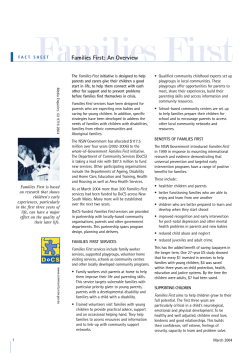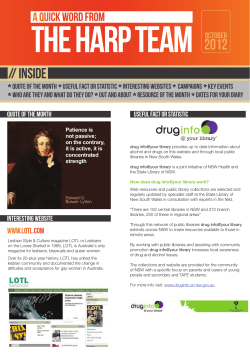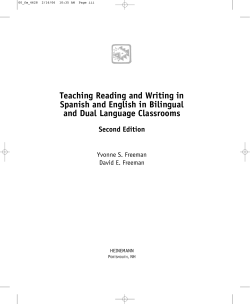
Supporting bilingual children in early childhood T
www.learninglinks.org.au Information Sheet 50 Supporting bilingual children in early childhood By Jane Purcell and Michelle Lee, Speech Pathologists, and Janette Biffin, Early Childhood Educator T his article aims to provide information about language development in bilingual children prior to school age and strategies to assist these children in early childhood settings. The information has been drawn from a workshop on Supporting Bilingual Children in Early Childhood Settings, presented by Learning Links’ Early Childhood Services. Types of bilingualism There are many definitions of bilingualism; however, most people define it as using two languages on a regular basis. The extent to which a person is bilingual can vary. Some people are equally proficient in two languages across a range of contexts and this is often referred to as ‘balanced bilingualism’. More often, when people are bilingual, one of the languages is used more regularly and with greater proficiency. This may be referred to as ‘dominant bilingualism’. There are also people who understand and use three or more languages and may be referred to as ‘multilingual’. This article focuses on supporting children who are acquiring two languages in early childhood settings. Acquiring more than one language There are two main ways to acquire more than one language: • simultaneous acquisition (when a child learns two languages at the same time); and • sequential acquisition (when the second language is learnt after the first). Simultaneous acquisition There are three identified stages when languages are acquired simultaneously: • Stage 1 – the child mixes two languages into one system; • Stage 2 – the child starts to separate the words from each language and recognises to which person that language should be spoken; and • Stage 3 – one language is used more than the other and that language becomes dominant, which is often the case. In simultaneous acquisition, there are two common patterns of exposure to a second language: • one person – one language (for example, where one parent or other family member speaks one language, and another parent or family member speaks a different language); or • both parents (or other family members) speak both languages. ln general, the ‘one person – one language’ approach helps children to separate and learn the two languages. Sequential acquisition There are also three identified stages which motivate and guide sequential language learners. • Stage 1 – the child observes speakers of the second language and may be silent; the child may communicate non-verbally (for example, pointing); later, the child relies on whole memorised phrases. • Stage 2 – the child communicates with others in the second language; the child starts to create their own sentences; the child communicates as best they can. • Stage 3 – the child attempts to speak correctly using correct vocabulary, grammar and pronunciation. In sequential acquisition, the way in which the second language is introduced and maintained is vital. In particular, it is important that languages are clearly separated rather than one person inconsistently using a mixture of two languages. When languages are learnt sequentially: • understanding the basic rules of the first language will support the development of a second language; EMBRACING THE DREAMS OF FAMILIES FOR THEIR CHILDREN Information Sheet 50 – Learning Links – Helping Kids Learn Learning Links is a non-profit charity assisting children who have difficulty learning and their families. We raise funds to help children from birth to 18 years by offering a range of services including the following. Early Childhood Services for children from birth to six years. Early childhood intervention and support for very young children. • An inclusive preschool for children with and without special needs. • An assessment and consultancy service for families who are concerned about their young child’s development. • Specialist early childhood teaching and therapy. School Age Services for children from Kindergarten to Year 12 who have low support needs. • Comprehensive assessments. • Small group tuition and therapy. • Occupational and speech therapy programs combining specialist education services and therapy. • Outreach programs. • The Ronald McDonald Learning Program for seriously ill children; Reading for Life for children falling behind in reading and Counting for Life for children falling behind in numeracy. Family Services helping and supporting families and health professionals. • Centre and home-based family counselling. • Parenting Programs and groups for families. • Case Management Services. Professional Development for teachers and health professionals. Presentations, workshops and advice on identifying and helping children with learning difficulties, learning disabilities and developmental delays. Learning Links has branches in six Sydney locations at Peakhurst, Penshurst, Fairfield, Miller, Brookvale and Randwick. We also offer some services to children in country NSW, the ACT, Western Australia, Victoria and New Zealand. A complete list of branch locations and contact numbers is on the back cover. Learning Links Head Office 12-14 Pindari Road Peakhurst NSW 2210 Tel: 9534 1710 Fax: 9584 2054 Email: mail@learninglinks.org.au Website: www.learninglinks.org.au Enquiries regarding this Information Sheet should be directed to Robyn Collins Tel: (02) 9534 1710 Fax: (02) 9584 2054 Email: rcollins@learninglinks.org.au © Learning Links 2006. The material in this publication cannot be reproduced without the written permission of Learning Links. • the best way for children to acquire English as a second language is for families to continue to support and consolidate their first language at home; and • if the original or home language is replaced by a second language and all support for the first is withdrawn, some children can lose skills in their first language (this can result in negative consequences for a child both within their family and the community, and in their future language development). Myths surrounding bilingualism There are many myths associated with bilingualism. • Myth: delays in language are caused by learning a second language. This is not true. Like any other child, a child who is bilingual can have language delays, but learning a second language neither increases nor decreases the chances of having a language delay. • Myth: it is easier to learn a second language if you stop using your first or home language and concentrate on the new language. The truth is that the stronger the first language is, the easier it is to learn a second language. • Myth: parents should stop using the first or home language when the child begins speaking a second language such as English. In fact, the best way for families to support children learning English is to maintain the child’s first language at home. Parents don’t have to talk in English to help their child learn English. It is more important that parents use the language that they can use best and are the most comfortable speaking. When they do this they can provide models of grammatically correct sentences and access to a wide vocabulary. Parents should therefore continue to use their first language to talk to their child about everyday activities such as shopping, and share poems, stories, songs, books and games. It can also help if parents use the name of the language (for example, Mandarin or Cantonese), when speaking in this language to their child. Factors affecting the rate of acquisition of English as a second language There are a number of factors that influence the rate of acquisition of English as a second language. These include: • the length of time exposed to English; • the extent of the exposure to English; • the age of the child when they are first exposed to English; • the ways in which the child is exposed to English; • the similarities and differences between English and the home language; • the acceptance and value given to English and the home language; • individual characteristics within families – their strengths, needs and support; and • individual characteristics of the child (including personality, confidence and learning styles) that may influence their willingness and readiness to interact with others and try to use their new language. What to expect when children are learning a second language Many children become silent when first exposed to a second language. This silent period can last months and can be important in developing understanding. During this period it is important to allow children time to just observe without pressure to speak. At this time, children often rely on adults around them and on non-verbal cues in the environment; for example, adults pointing to what they are talking about or asking the child to do. They also often follow other children and imitate them. It is not unusual for bilingual adults to switch between languages within a sentence and this can in fact enhance communication. Similarly, it is normal for children who are learning a new language to mix the two languages when making sentences. Children who are learning English often begin by using short social phrases; for example, “my turn”, “chase me”, “help me”. They usually find these phrases easy to use and often get positive results from other children and adults. Information Sheet 50 – Learning Links – Helping Kids Learn Identifying language delays It can be a challenging and complex task determining whether a child acquiring a second language has a language delay or is just in the process of learning English (perhaps at a slow rate). If a child has a language delay, they will have a delay in both languages. When there are concerns about a child’s language development in either language, or their rate of acquisition of a second language, it is advisable to seek advice or an assessment. At such an assessment, information will be sought about what languages are spoken at home and how the child’s first language developed. This will include information about the child’s ability to understand what is said, use words, construct sentences, and use different languages to communicate with different adults, as well as some information about the child’s social development. There are some bilingual speech pathologists who can assess a child in languages other than English. Speech Pathology Australia has a list of private speech pathologists who are bilingual. A bilingual speech pathologist may also be accessed through local or government services. It is important that the child’s first language is acknowledged, as well as its continued use at home. It is similarly important to observe what children are interested in, and what motivates them, so these activities or experiences can be included in early childhood programmes. Being bilingual does not increase or decrease the chance of having a language delay. Just as there are children who speak one language and have a language delay, there are also bilingual children who have a delay. If early childhood workers know more about what to expect when children are learning a second language, they can have appropriate expectations. By knowing, for example, that some children will go through a silent period, they can recognise this stage and not pressure children to speak. Supporting bilingual children in early childhood settings There is no single approach that will work for all bilingual children, or children learning a second language. Workers in early childhood settings can support children by finding out all that they can about them, their families and their culture. For many children, having an adult to support them during this silent period can help develop their understanding of the second language. If children are showing signs of being ready to join in activities, early childhood staff can encourage them, provide support and praise them. What is it like to grow up with two languages? Learning Links has two staff members who learnt English as a second language – one speaks Arabic and English and the other, Swedish and English. Here are their thoughts and recollections about learning two languages. Swedish and English – Sophia Andersson “I was born in Sweden to Swedish parents (Swedish-speaking) so I learnt Swedish as my first language,” said Sophia. “At the age of seven my family and I moved to Australia. I had no English at this time, neither did my mother. My father and sister had some English. “We continued to speak Swedish at home and with people in the local Swedish community. “The principal at my school advised us to only speak English at home, but as this would mean that we could not communicate as a family we ignored her advice and continued to speak Swedish at home. “I was enrolled in a Year 1 class but spent time daily in an intensive English class. My mother said that I did not attempt to speak any English for up to three months. “I also attended Swedish School for about two years when we first moved to Australia (once a week for a few hours). “Now I am fluent in spoken Swedish and can read the language. I can only write simple sentences in Swedish and find that my grammar is poor.” Sophia says English is now her stronger language but she continues to speak Swedish with her family and people within the Swedish community. “I think in English but am able to switch from English to Swedish and vice versa without thinking,” said Sophia. Sophia feels lucky to be bilingual, especially as she learnt English at such a young age and does not recall it being difficult to learn. Unfortunately there are not many opportunities to speak Swedish in Australia. “As English has been such a big part of my family’s communication over the last 24 years, we now find that we speak “Swinglish” (a mixture of English and Swedish), said Sophia. “For example, when I speak Swedish, if I don’t know the word in Swedish I will add an English word into the middle of the sentence. “I don’t think about the similarities and differences,” she said, “speaking both languages is just something I do.” Arabic and English – Farah Elmir Although Farah speaks both English and Arabic, like Sophia, English is also her stronger language. “I was exposed to English from the age of five at school,” said Farah. “ESL (English as a second language) classes were helpful, but I remember that I felt isolated from friends as I had to be removed from class during normal class time.” Farah and her parents do not recall being given any advice about learning or using two languages when she started school. As an adult, like Sophia, Farah also feels very lucky to be bilingual. “I can utilise my second language for all sorts of things including work if an interpreter is needed. I can also speak Arabic with my family.” Farah is now a mother and wants her children to learn two languages. The children’s grandparents are taking the initiative and speaking to them in Arabic. Farah and her husband Allan have decided to speak to their children in English to avoid mixing the two languages. Information Sheet 50 – Learning Links – Helping Kids Learn As in all early childhood settings, children will learn through play, routines, books, games and songs. As part of these activities, staff can support language development by modelling and repeating meaningful words and phrases (for example, ‘wash hands’, ‘come play’). Using gesture and visual materials such as photographs can also greatly assist children’s understanding of language and their acquisition of words. Children learning a second language can also be included in non-language activities (for example, picture matching) and activities that stimulate a range of senses (for example, water play). These activities allow children to demonstrate their competencies and participate without language. Resources/Other Services First Steps Literacy Kit Early Literacy Resources for Parents Available from: Fairfield Children’s Resource Centre Tel: (02) 9724 7948 Community Life – Tel: (02) 9725 0393 Gowrie Library (Erskineville) has a range of multicultural resources – Tel: (02) 8345 7624 Ethnic Child Care Family and Community Services (Marrickville) – Tel: (02) 9569 1288 Contact Inc 1st Floor 30 Wilson Street Newtown NSW 2042 Telephone: (02) 9565 1333 Fax: (02) 9565 1477 NSW Multicultural Health Communication Services Website: www.http://mhcs.health.nsw. gov.au Email: mhcs@doh.health.nsw.gov.au Telephone: (02) 9382 8111 Anglicare Migrant Services www.anglicare.org.au 36 Cumberland Street Cabramatta NSW 2166 Telephone: (02) 9726 1500 Fax: (02) 9725 6175 They also provide opportunities to interact with peers, who can also assist when children are learning a second language. Children can vary markedly in their willingness to initiate, attempt and take risks. By tuning in to children’s strengths and needs, early childhood workers can help children’s communication to be a positive and rewarding experience. Learning Links uses a total communication approach to support the varied learning needs of children, including children learning a second language. (See box on this page for more information.) A Total Communication Approach Children, like adults, have different abilities, ways of learning and communicating. Learning Links’ Early Childhood Services uses a Total Communication approach to support the varying learning and skills of all children. Using a Total Communication approach can involve listening, speaking, gestures or hand movements, Makaton, facial expression, photos and pictures. Another name for a Total Communication approach is Alternative and Augmentative Communication. By using a Total Communication approach for children we are mirroring the diverse ways in which we communicate as adults. All children at Learning Links’ Preschool are exposed to a Total Communication approach. It aims to give children increased opportunities to understand what is said to them and to communicate their wants, needs, thoughts and feelings. Children learn that communication can happen in many different ways; for example, you can use your hands to talk or point to a photo to get something you want. A Total Communication approach can also assist children in developing social skills. Picture charts can show how to ask for a turn in a game, a ‘wait’ sign to remind them to wait until it is their turn and pictures to help them know what to do when they’re angry. When we support children in this way we can reduce frustration that can often be expressed in other ways such as biting or hitting. For children who have difficulties in communicating a Total Communication approach can be particularly important. Life can be very frustrating for families who cannot communicate with their child and equally as frustrating for the child who cannot communicate with them. A Total Communication approach increases the participation of children who may not be using words, such as children learning English as a second language. One way of doing this is to show pictures of songs, games and activities. These can allow children to make choices and demonstrate their preferences and competencies. Makaton (hand gestures) can also be of great benefit to children. Children can use it as a positive tool to help them get what they want. Early exposure to a range of Total Communication options can create a language-rich environment. By immersing children in spoken, written and visual forms of communication such as pictures and Makaton, we help children make connections between what is said and seen. When introducing a Total Communication approach it is important to incorporate children’s interests and things that motivate them. Later we can include choices that we as adults would like children to know and act on. These might include listening and looking at group time. Another way of helping children is to include Total Communication in everyday activities such as during morning tea or lunch. Children can be encouraged to participate in mealtimes when they have individual placemats showing pictures of their favourite foods. Making the activity fun and decreasing pressure can also help. By using pictures or Makaton in everyday activities we are making Total Communication part of a child’s life. Information Sheet 50 – Learning Links – Helping Kids Learn www.learninglinks.org.au Early Childhood Services – all enquiries to Head Office School Age Services – contact your local branch Family Services – contact your local branch All other enquiries – Head Office Head Office 12-14 Pindari Road Peakhurst NSW 2210 Telephone: (02) 9534 1710 Preschool: (02) 9533 3283 Facsimile: (02) 9584 2054 Email: mail@learninglinks.org.au Northern Suburbs Branch 2 Alfred Road PO Box 634 Brookvale NSW 2100 Telephone: (02) 9907 4222 Facsimile: (02) 9907 4244 Email: nsb@learninglinks.org.au Western Suburbs Branch Unit 7/9 William Street PO Box 1026 Fairfield NSW 1860 (2165) Telephone: (02) 9754 2377 Facsimile: (02) 9755 9422 Email: wsb@learninglinks.org.au Southern Suburbs Branch 10 Railway Parade Penshurst NSW 2222 Telephone: (02) 9580 4888 Facsimile: (02) 9580 4788 Email: ssb@learninglinks.org.au South West Sydney Branch 88 Shropshire Street PO Box 42 Miller NSW 2168 Telephone: (02) 8783 7111 Facsimile: (02) 8783 7222 Email: sws@learninglinks.org.au Eastern Suburbs Branch 1/20 Silver Street Randwick NSW 2032 Telephone: (02) 9398 5188 Facsimile: (02) 9326 5364 Email: esb@learninglinks.org.au Ple ase help us help children Please PRINT N I would like to donate $________________to help kids who have difficulty learning. N I would like to be a member of Learning Links. Please tick appropriate box below. N Individual or Family $45 (including GST) N Professional $45 (including GST) N Not for profit Organisation $55 (including GST) N Corporate $70 (including GST) Individual, Family and professional membership includes one copy of Learning Links News I enclose my: Charge my: N Cheque N Money Order or N Bankcard N Visa N Mastercard N AMEX Account No: _______ _______ _______ _______ _______ _______ _______ _______ _______ _______ _______ _______ _______ _______ _______ _______ CCV*: _________________________ Visa and Mastercard last 3 digits on back of card. Account Name: _______________________________________________________________________________________________________________________________________ Expiry Date: ______ /________ Signature: __________________________________________________________________________________________________________________________________________________________________________________ Name (Dr, Mr, Mrs, Miss, Ms): _ ________________________________________________________________________________________________________________________________________________________ Organisation/Business: _ _______________________________________________________________________________________________________________________________________________________________ Address: ____________________________________________________________________________________________________________________________________________________________________________________ ________________________________________________________________________________________________________________________________________________________ Postcode: _ ______________________ Tel: (Home): ____________________________________________________________________________ (Business): ____________________________________________________________________________________ Please post to Learning Links: 12-14 Pindari Road, Peakhurst NSW 2210. Donations over $2 are tax deductible and will be receipted.
© Copyright 2025





















